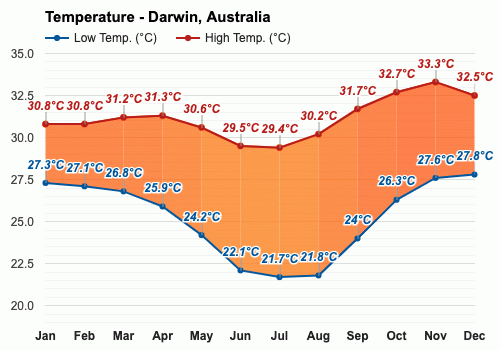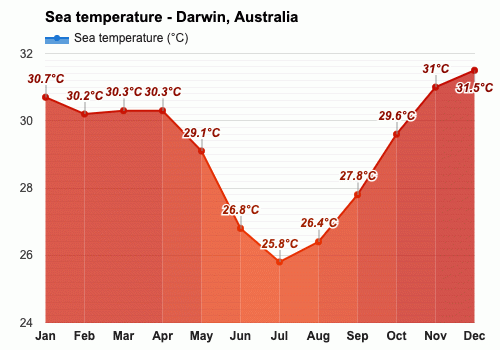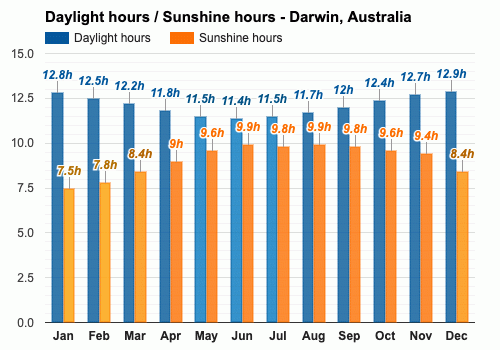Contents
- Weather in March
- Frequently asked questions
- Average temperature in March
- Average pressure in March
- Average wind speed in March
- Average humidity in March
- Average rainfall in March
- Average rainfall days in March
- Average sea temperature in March
- Average daylight in March
- Average sunshine in March
- Average sunshine days in March
- Average UV index in March
- Average cloud cover in March
- Average visibility in March
Weather in March
Temperature
March's weather records an average high-temperature of a still tropical 31.2°C (88.2°F), showing little deviation from February. Darwin notes a consistent average low-temperature of 26.8°C (80.2°F) during March nights.Heat index
March's mean heat index is appraised at a blistering 40°C (104°F). Undertake additional precautions, heat cramps and heat exhaustion could happen. Heatstroke could occur from sustained activity.Take into consideration that the heat index values are calculated for shade and light wind conditions. With exposure to direct sunlight, the heat index may be increased by up to 15 Fahrenheit (8 Celsius) degrees.
Note: The heat index, also known as 'felt air temperature' or 'real feel', quantifies the warmth felt when relative humidity is considered. The impact of temperature is individual, as people's perception of weather may change based on their body mass, height, and physical activity. Direct exposure to sun rays can potentially augment the heat sensation, elevating the heat index by up to 15 Fahrenheit (8 Celsius) degrees. Heat index values are highly critical for babies and toddlers. Young individuals are generally in more danger than adults due to their lower capacity to sweat. Moreover, their large skin surface in relation to their small bodies and the increased heat generation from their activities makes them more vulnerable.
Perspiration is the body's default response to elevated temperatures, as it promotes the evaporation of sweat to achieve cooling. Relative humidity in excess curtails evaporation, therefore reducing heat dissipation from the body, leading to feelings of excess heat. Heat disorders may be on the horizon when body temperatures rise from inadequate heat management.
Humidity
The average relative humidity in March in Darwin is 76%.Rainfall
In Darwin, in March, during 27.8 rainfall days, 219mm (8.62") of precipitation is typically accumulated. In Darwin, Australia, during the entire year, the rain falls for 191.8 days and collects up to 1282mm (50.47") of precipitation.Sea temperature
In Darwin, the average seawater temperature in March is 30.3°C (86.5°F).Note: When water's temperature exceeds 30°C (86°F), it arguably loses its primary appeal of offering a cool escape.
Daylight
In March, the average length of the day in Darwin is 12h and 10min.On the first day of the month, sunrise is at 6:48 am and sunset at 7:09 pm. On the last day of March, in Darwin, sunrise is at 6:51 am and sunset at 6:50 pm ACST.
Sunshine
In March, the average sunshine in Darwin is 8.4h.UV index
The months with the lowest UV index in Darwin are January through October and December, with an average maximum UV index of 7. A UV Index value of 6 to 7 symbolizes a high health vulnerability from exposure to the Sun's UV radiation for average individuals.Note: In March, the UV index of 7 transforms into the following advice:
Stick with precautions and abide by sun safety procedures. Evading sunburn is essential. The time between 10 a.m. and 4 p.m. is when UV radiation is at its peak. Limit exposure to direct sunlight during these hours. For holistic sun protection encompassing the eyes, ears, face, and neck, a wide-brim hat is key. Heads up! UV intensity is amplified by reflections from water and sand.
Frequently asked questions
How hot does it get in Darwin in March?
What is the average humidity in March in Darwin?
How much does it rain in Darwin in March?
How warm is the water in March in Darwin?
What is the average length of the day in March in Darwin?
What time are sunrise and sunset in March in Darwin?
How many hours of sunshine does Darwin have in March?
What is the month with the lowest UV index in Darwin?
What is the UV index reading in March in Darwin?
Average temperature in March
Darwin, Australia

- Average high temperature in March: 31.2°C
The warmest month (with the highest average high temperature) is November (33.3°C).
The month with the lowest average high temperature is July (29.4°C).
- Average low temperature in March: 26.8°C
The month with the highest average low temperature is December (27.8°C).
The coldest month (with the lowest average low temperature) is July (21.7°C).
Average pressure in March
Darwin, Australia

- Average pressure in March: 1008mbar
The months with the highest atmospheric pressure are July and August (1013.2mbar).
The month with the lowest atmospheric pressure is January (1006.3mbar).
Average wind speed in March
Darwin, Australia

- Average wind speed in March: 11.4km/h
The windiest month (with the highest average wind speed) is January (15.3km/h).
The calmest month (with the lowest average wind speed) is September (9.9km/h).
Average humidity in March
Darwin, Australia

- Average humidity in March: 76%
The months with the highest relative humidity are January and February (78%).
The month with the lowest relative humidity is June (57%).
Average rainfall in March
Darwin, Australia

- Average rainfall in March: 219mm
The wettest month (with the highest rainfall) is January (340mm).
The driest months (with the least rainfall) are June, July and August (2mm).
Average rainfall days in March
Darwin, Australia

- Average rainfall days in March: 27.8 days
The month with the highest number of rainy days is January (28.3 days).
The month with the least rainy days is June (1.9 days).
Average sea temperature in March
Darwin, Australia

- Average sea temperature in March: 30.3°C
The best month for swimming (with the highest average sea temperature) is December (31.5°C).
The coldest month (with the lowest average sea temperature) is July (25.8°C).
Average daylight in March /
Average sunshine in March
Darwin, Australia

- Average daylight in March: 12h and 1min
The month with the longest days is December (Average daylight: 12h and 48min).
The month with the shortest days is June (Average daylight: 11h and 24min).
- Average sunshine in March: 8h and 2min
The months with the most sunshine are June and August (Average sunshine: 9h and 54min).
The month with the least sunshine is January (Average sunshine: 7h and 30min).
Average sunshine days in March
Darwin, Australia

- Average sunshine days in March: 1.8 days
The month with the most sunshine days is July (28.4 days).
The month with the least sunshine days is February (0.9 days).
Average UV index in March
Darwin, Australia

- Average UV index in March: 7
The month with the highest UV index is November (UV index 8).
The months with the lowest UV index are January, February, March, April, May, June, July, August, September, October and December (UV index 7).
Average cloud cover in March
Darwin, Australia

- Average cloud cover in March: 36
The month with the most cloud cover is January (Cloud cover 47).
The month with the least cloud cover is August (Cloud cover 9).
Average visibility in March
Darwin, Australia

- Average visibility in March: 9km
The months with the highest visibility are April, May, June, July, August, September, October and November (10km).
The months with the lowest visibility are January, February, March and December (9km).
Darwin, Australia
Weather forecast for your location
2. Allow the app to use your location


